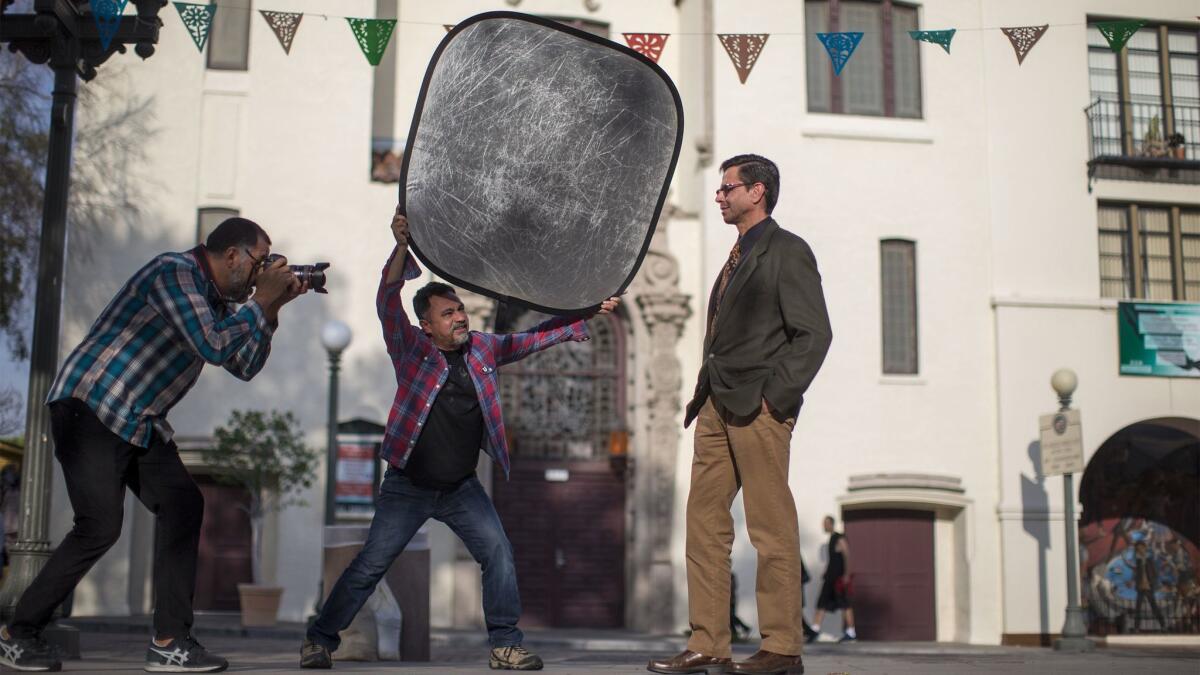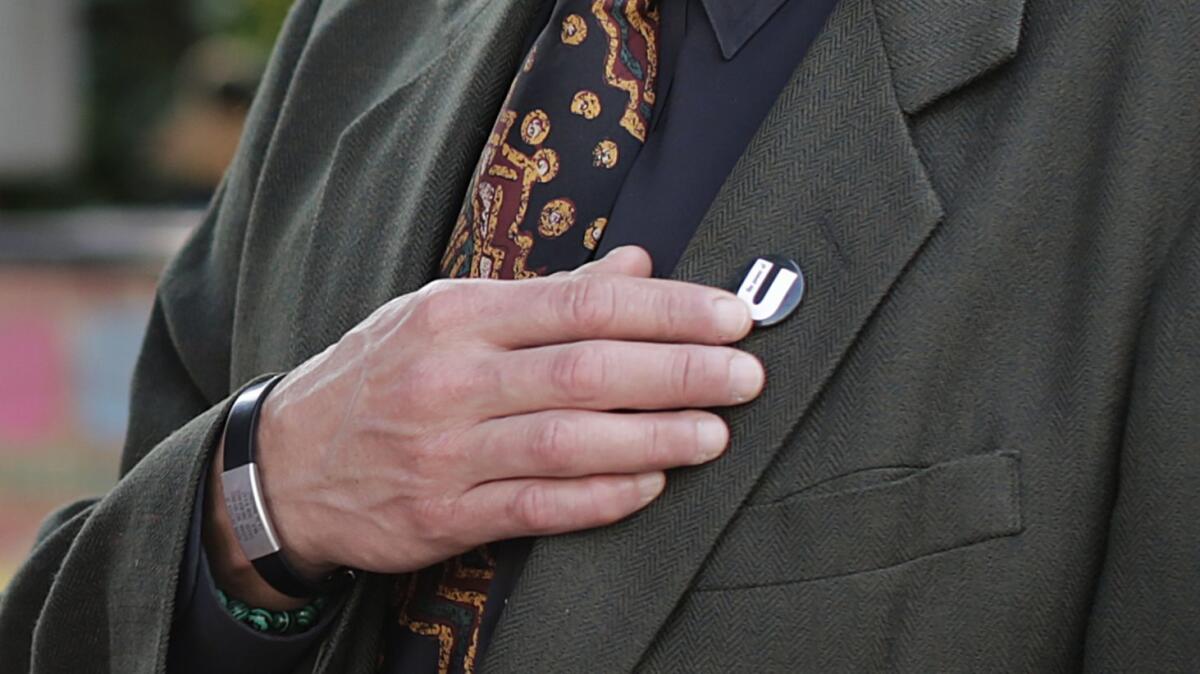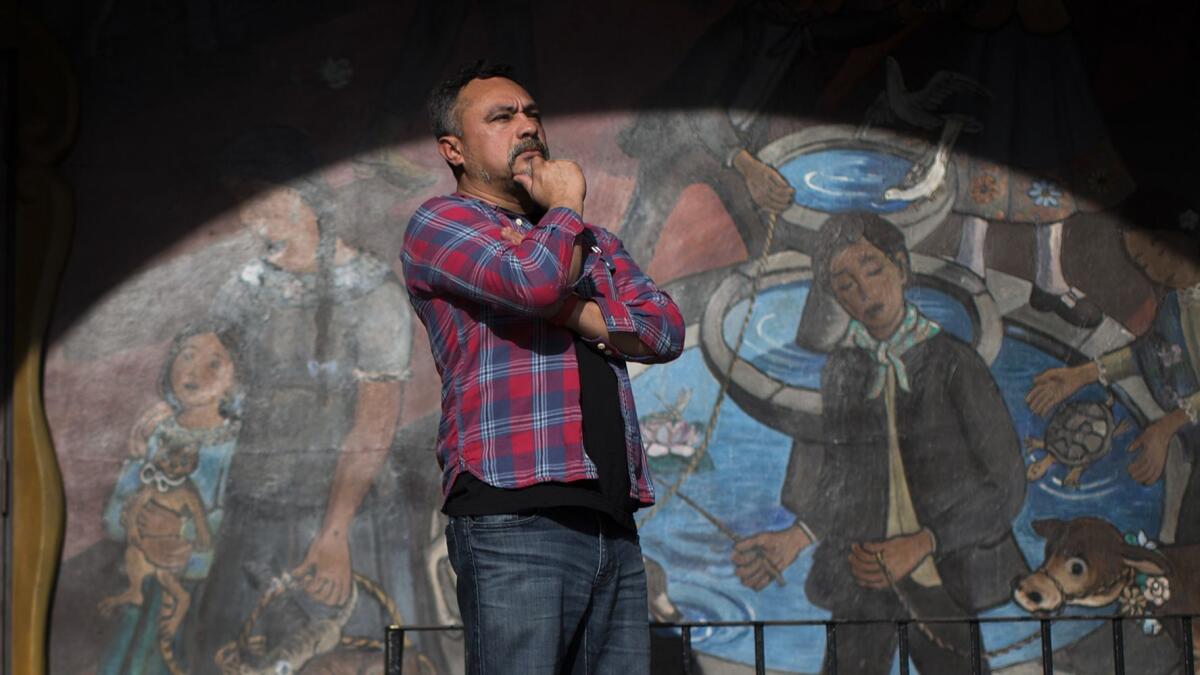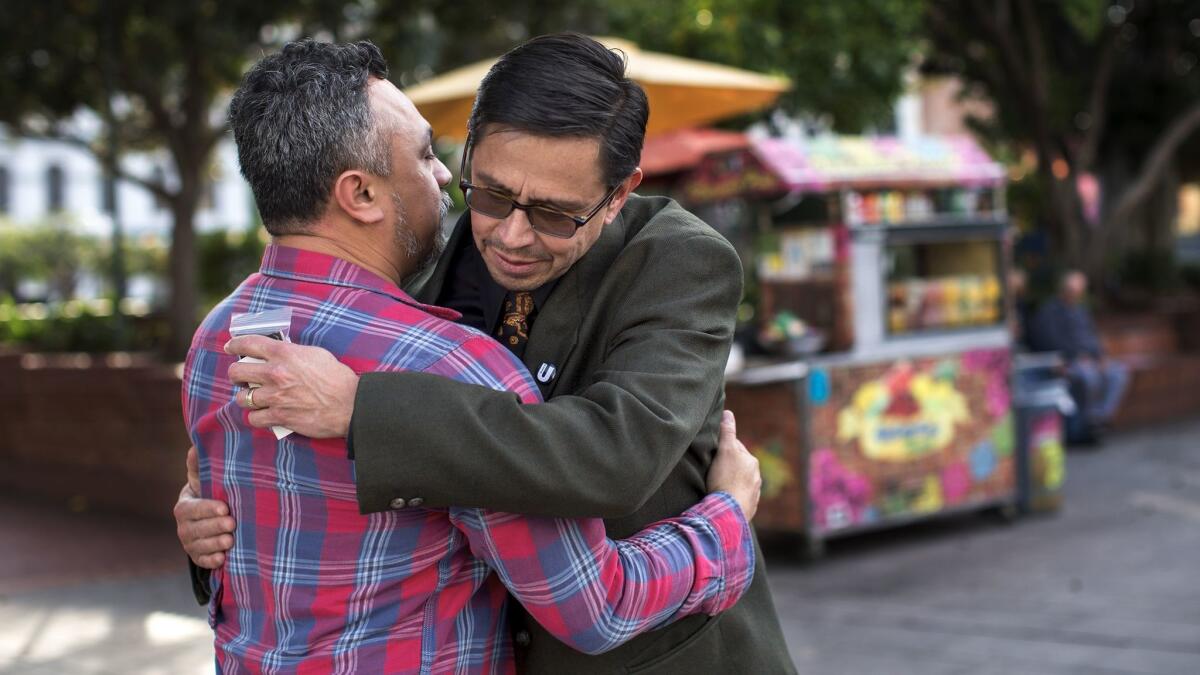He wanted formerly undocumented immigrants to go public. Then Trump won

When Trump was elected, Miguel Luna thought of abandoning his project. (March 29, 2017)Â (Sign up for our free video newsletter here http://bit.ly/2n6VKPR)
When Miguel Luna began to wear the little black pin, he wasnât sure how people would react.
âIâm either going to get hugged or Iâm going to get punched,â he told his wife.
The presidential election was a few days away and Luna had just launched an online photo project that he called âthe Power of U.â
U stood for undocumented, and the idea was to share the stories of the formerly undocumented, and of their parents and grandparents. He would take their photos and gather their tales and then give each a black pin to wear, bearing the white letter U.
Luna thought people would proudly wear the pin and heâd collect 100 stories by the end of 2016.

Project photographer Noe Montes, left, photographs Adan Ortega of Fullerton for Miguel Lunaâs, middle, Power of U project on Feb. 8, 2017, in Los Angeles.
Then Donald J. Trump won the presidency, and everything changed. Much of the confidence immigrants without legal status had felt for years seemed to have been zapped overnight.
âWe couldnât believe it,â Luna said. âWe were all walking around like zombies.â
No longer would undocumented people out themselves during protests. Or chain themselves to federal buildings to demand reform. Or confidently share their names with the media.
Many today are anxious even showing up to work.
Luna doesnât include people who are still undocumented in his project. Heâs afraid of putting them in harmâs way.
He focuses instead on permanent residents and citizens. But these days, even they worry about putting less-secure relatives at risk.

Luna, a community organizer who focuses on environmental justice, considered canceling his project.
âThis could turn into a headache,â he thought.
But then he decided that telling these stories now was more important than ever.
As he collected them, he felt their strength:
The mother of Diego Ortiz, a youth advocate, escaped her town in El Salvador with her son in the 1980s, the night before guerrillas came charging in to force the young men into war. Arturo Ramirez, a mariachi organizer, arrived in Los Angeles from Mexico knowing no one and lived in an auto body shop for weeks before he found housing.
Pablo Cordosos, a program director for the Los Angeles Conservation Corps, came from Mexico with his mother and five siblings in the 1970s to join his father, who was already there. Before they crossed into San Diego, their coyote had everyone put on shorts and carry beach toys â so they would blend in and get past authorities.
On his website, Luna also tells the tale of Salvador Garcetti, who entered the United States illegally from Chihuahua, Mexico, in the early 1900s. His father, a judge, was hanged during the Mexican Revolution. His grandson is now the mayor of Los Angeles.
Luna was 8 when he came north from Colombia with his mother. Theirs was a monthlong journey via plane, ferry, taxi and bus.
On the final bus ride, his mother told him to sit away from her and pretend to sleep â no matter what happened. When night fell, two men got on the bus and took his mother.
âI felt paralyzed,â Luna said. âAll I could do was squint my eyes and see the shadows of the border patrol.â
It would be four months before the two would see each other again. Luna lived with his aunt Luz, a woman he hardly knew. It took his mother two more tries to reach him.
Growing up in Los Angeles, Luna kept his family legal status a secret until he became a permanent resident.

Today, he finds his subjects through friends and referrals. He and photographer Noe Montes drive all over Los Angeles to meet them, at parks, restaurants, office buildings and on hiking trails. He spends at least an hour listening to each one, wrapped up in the drama and lessons of each journey. In January, he began recording the tales so people could hear the storytellersâ voices.
He has more than 30 portraits so far. He pays for the project himself and dreams one day of a gallery exhibit.
On a recent afternoon, Luna went to Olvera Street to meet with Adan Ortega, who lives in Fullerton and runs a government affairs firm.
Ortega, 54, was born in El Paso. His father immigrated illegally to the United States at age 16.
Ortega never had to experience the fear of being deported, but his first-generation journey was similar.
âYouâre a tapado,â he said, a word immigrants often use to describe how clueless they felt when they first arrived in this country.
Growing up in Boyle Heights, he was teased for speaking Spanish â particularly by fellow Latinos.
âTheyâd tell me, âGo back to Tijuana,â â Ortega said.
One of Lunaâs first subjects was Felipe Escobar of North Hollywood, who was supposed to have been born in Los Angeles in 1987.
But his parents, both of whom had entered the United States illegally, got into a fight â and his pregnant mother returned to Guatemala.
He lived there with his grandma until he was 11, then traveled north and crossed the border into the U.S. illegally in order to reunite with his family. He eventually became a citizen with the help of his father, who had received amnesty.
Today, the 29-year-old is a community organizer with Pacoima Beautiful, a group that works to improve the safety and health of neighborhoods.

Escobar has a U pin, but most days prefers to wear his âPower of Uâ shirt.
âI feel empowered when I wear it,â he said. âLike Iâm part of a bigger movement thatâs made a difference and made America what it is today.â
Getting people behind his project isnât always easy for Luna. Some question how their information will be used. They worry they might be too exposed.
They tell Luna: âI donât want to be on any list.â
Even his longtime friend Miriam turned him down. She said yes, then changed her mind after Trumpâs election. When asked about it, she requested that her last name not be used.
âHeâs going to make examples out of people,â the 34-year-old said. âSo why put yourself out there?â
Miriam came into the U.S. illegally when she was 12 and is now a citizen. But she has relatives in the country who lack legal status.
She spends her time calling elected officials and donating to organizations that defend immigrant rights.
âWeâre not going to change other peopleâs minds by doing this,â she said of Lunaâs project. âNow, we have to be on the defensive, to protect the people who are here.â
Luna understands her perspective. He has come to expect criticism.
Someone recently messaged him to ask when he plans to tell the stories of immigrants who migrated legally, who âwaited their turn and stood in line.â
Thatâs not the kind of reaction he hopes for.
Each day, he says, it gets harder to wear the pin. But he does it because he thinks itâs important.
âWhether the outcome is positive or negative,â he said, âour stories need to be told.â
ALSO
Why record snow followed by warm temperatures is a dangerous combination for Owens Valley
More to Read
Sign up for Essential California
The most important California stories and recommendations in your inbox every morning.
You may occasionally receive promotional content from the Los Angeles Times.
![[20060326 (LA/A20) -- STATING THE CASE: Marchers organized by unions, religious organizations and immigrants rights groups carry signs and chant in downtown L.A. "People are really upset that all the work they do, everything that they give to this nation, is ignored," said Angelica Salas of the Coalition of Humane Immigrant Rights. -- PHOTOGRAPHER: Photographs by Gina Ferazzi The Los Angeles Times] *** [Ferazzi, Gina -- - 109170.ME.0325.rights.12.GMF- Gina Ferazzi/Los Angeles Times - Thousands of protesters march to city hall in downtown Los Angeles Saturday, March 25, 2006. They are protesting against House-passed HR 4437, an anti-immigration bill that opponents say will criminalize millions of immigrant families and anyone who comes into contact with them.]](https://ca-times.brightspotcdn.com/dims4/default/d699c9b/2147483647/strip/true/crop/1977x1322+112+0/resize/320x214!/quality/75/?url=https%3A%2F%2Fcalifornia-times-brightspot.s3.amazonaws.com%2Fzbk%2Fdamlat_images%2FLA%2FLA_PHOTO_ARCHIVE%2FSDOCS%2854%29%2Fkx3lslnc.JPG)










